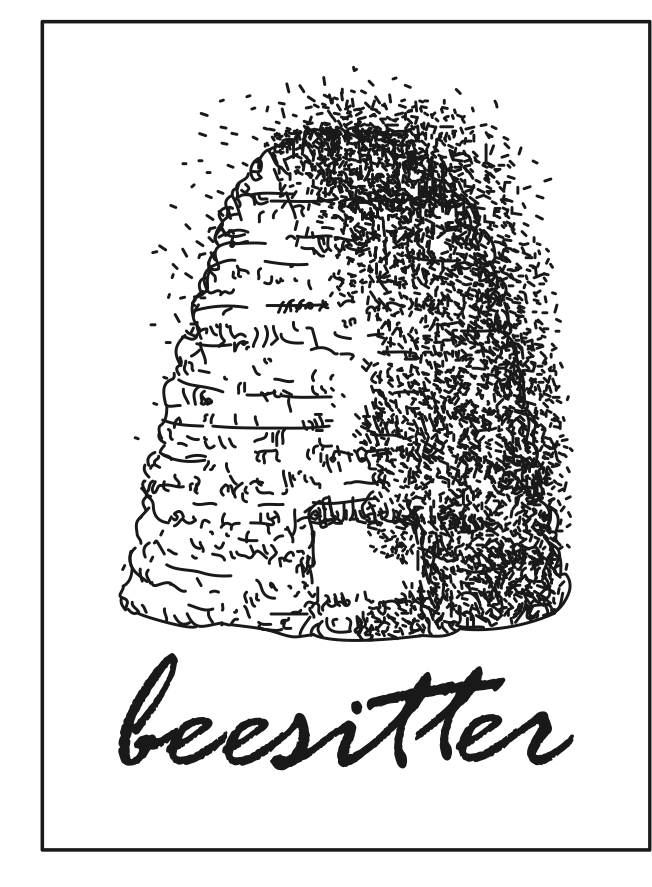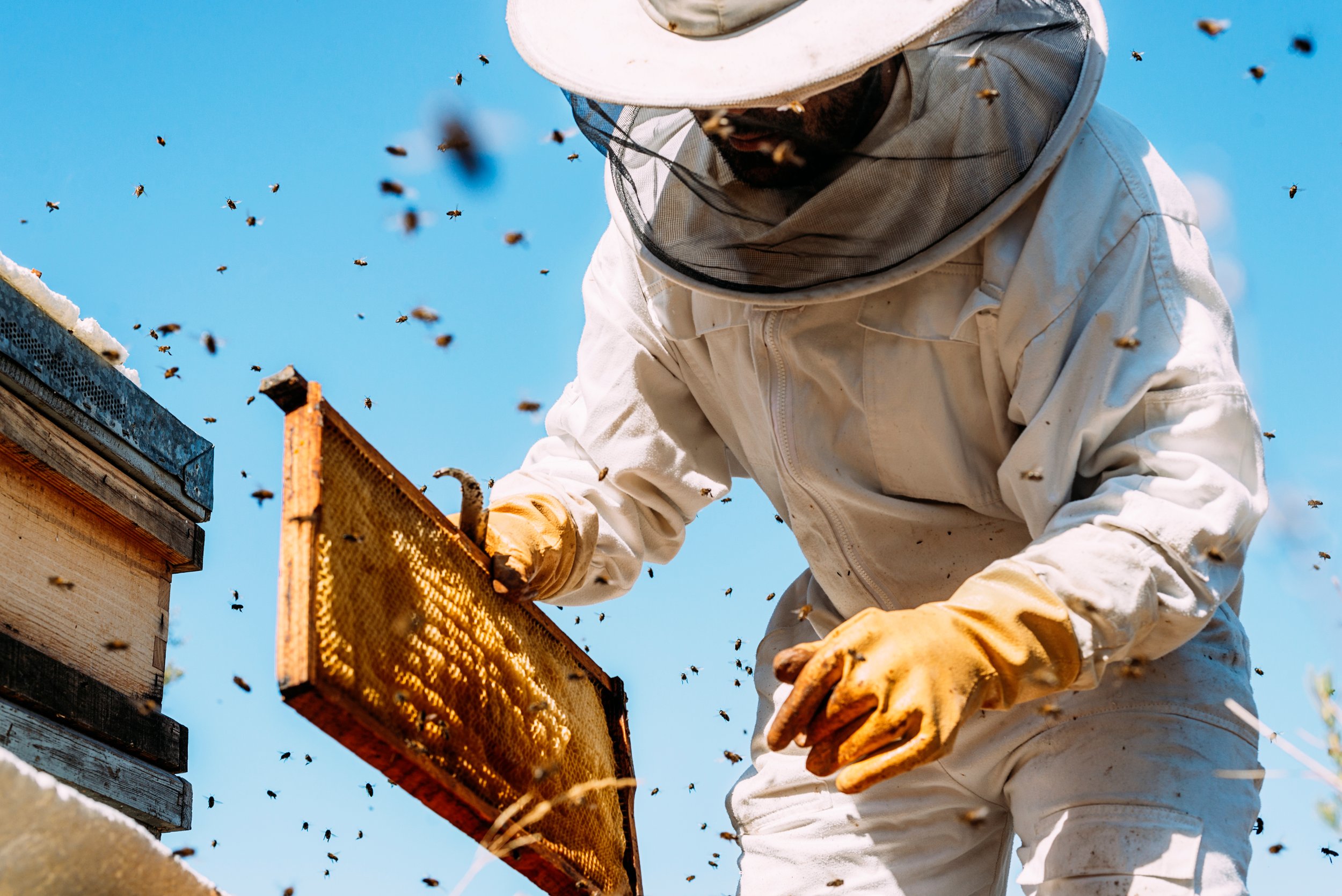Choosing my first beekeeping suit
The most important part of a beesuit is the veil that will be used to protect your face from potential bee stings. It is a must have protection when working with bees, as stings on the soft skin of the face are more painful and get more swollen. The veil can be worn on its own by securing it on top of your clothes with a system of strings and elastics or as part of a bee suit.
Types of veil:
The square veil is not often used because its design offers reduced visibility. This type of veil is generally sold on its own and can rarely be found as part of a bee suit or a jacket. It also requires using a hat on top that is usually bought separately. Although not being the most practical, the main perk of the square veil is its small price (around £10/13$) which can be appreciated by beekeepers having a small budget.
Don’t worry about sounding professional. Sound like you. There are over 1.5 billion websites out there, but your story is what’s going to separate this one from the rest. If you read the words back and don’t hear your own voice in your head, that’s a good sign you still have more work to do.
Be clear, be confident and don’t overthink it. The beauty of your story is that it’s going to continue to evolve and your site can evolve with it. Your goal should be to make it feel right for right now. Later will take care of itself. It always does.
The round veil offers great visibility and mobility. The tulle is attached to the rim of the round hat, which enables you to move your head in all directions without having the veil touching your face. Chose the size of the hat carefully so it fits nicely on your head. The hat can also be secured with a cord around your chin to prevent the veil form rotating on your head. The main drawback of this type of veil is its bulkiness. The round veil can be difficult to fold and carry around if you have frequent visits to an out-apiary. However, some bee suit providers took this into consideration by designing compact and foldable round veils.
A beekeeping round veil offers great visibility
The fencing veil is functional, very practical and favoured by many beekeepers. It offers slightly less visibility compared to the round veil and it is advisable to choose the right hood size. If the hood is too big for your head, it will hang to low and partially block your lateral vision. Because of its design, the veil can easily fold back and come into contact with your face when lifting your head up. This is only a minor disadvantage as most beekeeping tasks are performed with your head down.
Beekeeping suits and jackets:
Beekeeping suits and jackets have the veil directly secured to the collar with a zipper. These type of outfits are safer compared to a beekeeping veil worn alone. This should prevent you from having the unpleasant experience of a bee stuck in your veil. For this reason, beginners are strongly advised to invest in a good quality beekeeping suit or jacket.
The all-in-one beekeeping suit is the best protective clothing against bee stings. It is convenient to use as you only have one piece of clothing to put on. The obvious drawback of the bee suit is that you get quickly hot and sweaty while wearing it. In this case, the type of fabric that you choose can make a big difference. Some beekeeping retailers provide breathable bee suits that are made with meshed fabric or nylon instead of solid cotton fabric. These type of beekeeping suits are usually more expensive but more comfortable if you are working with bees in temperatures above 25°C (77°F). A good quality beekeeping suit will cost between 70£ -200£ (90-260$) but should last more than 10 years if well looked after.
If you don’t want to commit to the price of a beekeeping suit, the beekeeping jacket is a cheaper alternative that also offers good protection against bee stings when worn with thick trousers.
Beekeepers with all-in-one beesuits with fencing veil
Tips for choosing a beesuit:
1) Elastics: A good bee suit will have elastics around the ankles and the wrists to avoid bees crawling back in these areas. Most bee suits will also include an elastic hoop at the end of each sleeve to hook around your fingers and keep your sleeves in place.
2) Sturdy heavy-duty zippers: the weakest parts of a beekeeper suit are the front and collar zippers. Beekeeping jackets have usually one zipper around the collar which also tend to break after multiple uses. You can considerably increase the lifetime of your equipment by choosing a bee suit or jacket with metal zips instead of plastic ones.
3) The quality of the fabric will directly impact the lifetime of your bee suit. A strong cotton fabric will be durable. If you buy a breathable bee suit, make sure that the meshed fabric is of good quality and will resist weekly washings.
4) You should also take into consideration the thickness and quality of the net of the veil. A thick net will last longer but can be uncomfortable to look through. If you are wearing prescription glasses, try the veil with your glasses before purchasing your bee suit. Check also that the sewing around the veil is strong and secure.
5) Pockets: It is practical to have at least two waist pockets to hold your hive tool and your beekeeping notebook.
6) Finally, beekeeping suits can come in all sorts of colours and this choice totally depends on your personal taste. Just remember that dark colours should be avoided as it can trigger the bees defensive behaviour.
Our pick of the best beekeeping suits:
You will find in this section a selection of beekeeping suits from reputable brands that all meet the above criteria.
Humble bee beekeeping clothing:
Humble bee is a company founded in 2014 by two beekeepers and is selling great beekeeping protection clothing all over the world.
What we like about them: All their products are guaranteed for 2 years. We like the sturdy fabric carrying bag that comes with every bee suit or jacket. When buying a bee suit from humble bee you also contribute to a good cause as 10 % of their profits goes to charities that encourage local beekeeping and promote the conservation of bees. Finally, they have a friendly and efficient customer service if you experience any problems with your order.
beekeeping clothing from humble bees: The Polycotton Beekeeping Zipperless Jacket exists with a round veil, a fencing veil, and a square veil. For a little extra money, you can upgrade to the Ventilated beekeeping jacket which has a front zipper. The ventilated beekeeping suit is one of the most affordable breathable beekeeping suits on the market. That said, you will still get hot while wearing it when temperatures get above 30 °C. However, the meshed fabric and the cotton are of great quality so that you can wear very light clothing underneath without getting stung.
BJ Sherrif bee suits:
BJ sherrif is a UK company established since 1968. They offer high-quality beekeeping garments that have been constantly improved over the years.
What we like about them: They are reliable. You can be sure of the quality of their clothing as they have been in the beekeeping clothing industry for many years. We also like that they kept their production lines in the UK which is a good opportunity for UK beekeepers to buy local outfits.
Our selection of beekeeping suits: The S36 Apiarist is a fencing veil bee suit that comes in 12 different colours. They also offer a fully lined be suit, the B36 Bee Pro which includes a net lining underneath the polycotton suit that makes it very resistant to bee stings. This can be a good solution for unfortunate beekeepers with allergies to bee stings.
TAKE HOME MESSAGE:
If you are an absolute beginner, it is recommended to buy an all-in-one bee suit. The beekeeping suit will always be practical, even for experienced beekeepers, when performing tricky hive procedures or working with defensive bees. If chosen carefully your bee suit will last many years and you will not have to invest in another one for many years.
If you start gaining confidence and your bees have a gentle temperament, you might find that wearing a veil on its own is enough. This can give you a certain level of comfort in the hot summer months.
Finally, keep in mind that you want what is best for you and your bees. You should choose the most comfortable option that allows you to work safely around your bees.


